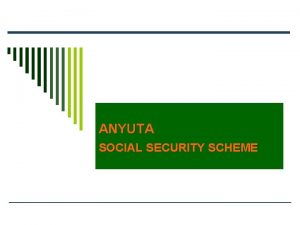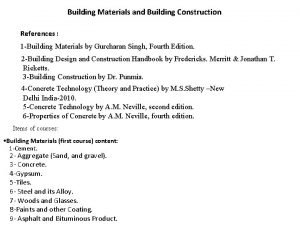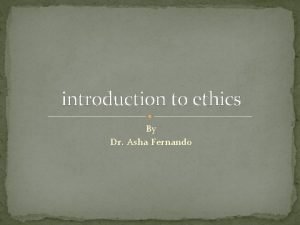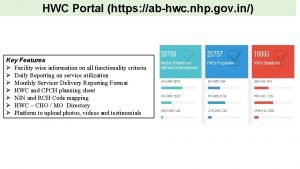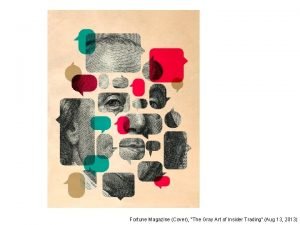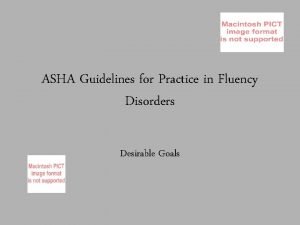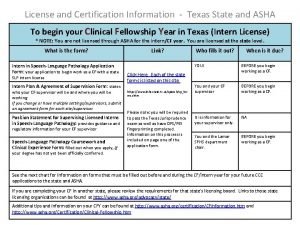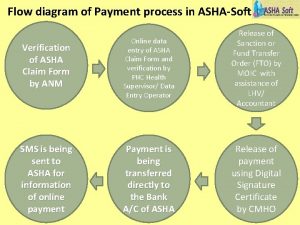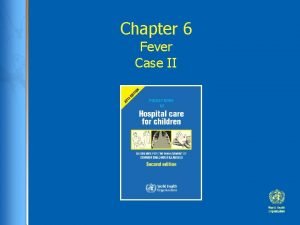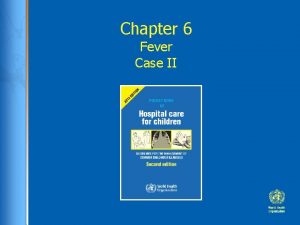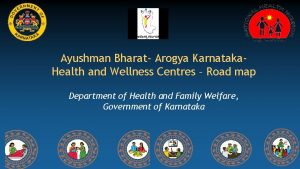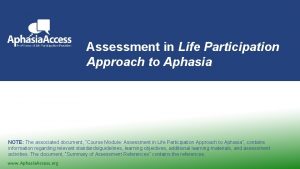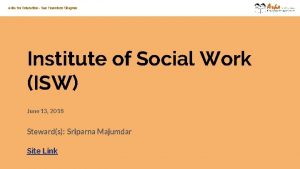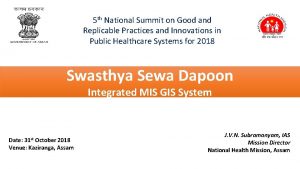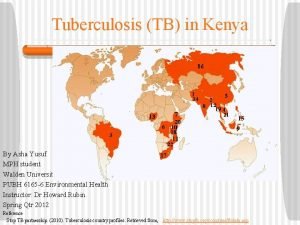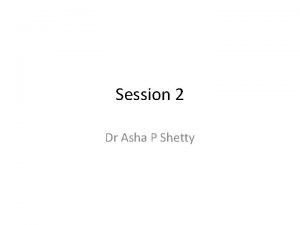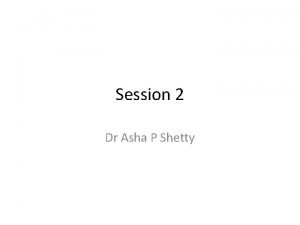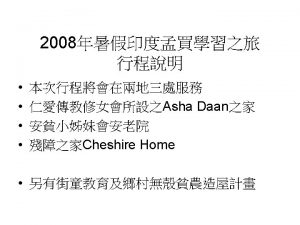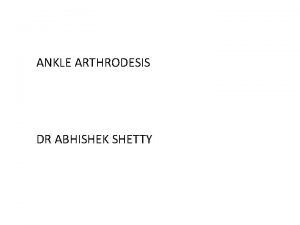Research Process Dr Asha P Shetty Research process
































- Slides: 32

Research Process Dr Asha P Shetty

Research process • Process=a course of action or proceeding, which can be followed for doing something. • The research process describes the steps that one needs to follow for conducting research. • The progression of activities differs for qualitative and quantitative 9/25/2020 2

Phase 1: The conceptual phase 1. 2. 3. 4. 5. Formulating and delimiting the problem Reviewing the related literature Undertaking clinical field work Defining the framework / developing conceptual definitions Formulating hypothesis Phase 2: The design and planning phase 1. 2. 3. 4. 5. 6. 7. Selecting a research design Developing a intervention protocols Identifying the population Designing the sampling plan Specifying methods to measure research variables Developing methods to safe guard subjects Finalizing the research plan Phase 3: The empirical phase 1. 2. Collecting the data Preparing the data for analysis Phase 4: The analytic phase 1. 2. Analyzing the data Interpreting the results Phase 5: The dissemination phase 1. 2. Communicating the findings Utilizing the findings in practice

Phases in a Quantitative Study • Phase 1: Conceptual Phase • Phase 2: Design and Planning Phase • Phase 3: Empirical Phase • Phase 4: Analytic Phase • Phase 5: Dissemination Phase

Phase 1: Conceptual Phase • Involves activities with strong conceptual or intellectual element. E. g. Reading, theorizing, reviewing ideas with colleagues or advisors. • Involves in skills such as creativity, deductive reasoning, insight and firm grounding in previous research.

• Phase 1: Conceptual Phase 1. 2. 3. 4. Formulating/delimiting the problem Reviewing related literature Undertaking clinical fieldwork Defining the framework and developing conceptual definitions 5. Formulating hypotheses

Step I: Formulating/delimiting the problem • Identify an interesting , significant research problems and good research questions. criteria of good research problem 9/25/2020 7

Step 2: Reviewing related literature Well before any data is collected • What is already known • Gives the base for new evidence 9/25/2020 8

Step 3: Undertaking clinical fieldwork • Clinical field work provides perspectives on recent clinical trends, current diagnostic procedures, relevant health care delivery models. • Helps to understand clients and their settings. 9/25/2020 9

Step 4: Defining the framework and developing conceptual definitions • Theory is the ultimate aim of science • Develop conceptual definitions. 9/25/2020 10

Step 5: Formulating hypotheses • Statement of researchers expectations about relationships between study variables. For e. g. : Is preeclamptic toxemia related to stress factors during pregnancy? • H 1: Women with higher incidence of stressful events during pregnancy will be more likely than women with lower incidence of stress to experience preeclamptic toxemia. 9/25/2020 11

Phase 2: Design and Planning Phase • Make decisions about the methods and procedures to be used. • Plan of actual data collection 9/25/2020 12

Phase 2: Design and Planning Phase 6. Selecting a research design 7. Developing intervention protocols 8. Identifying the population 9. Designing the sampling plan 10. Specifying methods to measure variables and collect data 11. Developing methods to protect human / animals rights 12. Finalizing the research plan

Step 6. Selecting a research design • The research design is the architectural backbone of the study. • Over all plan for obtaining answers to the questions being studied. • Specify which design is adopted • What will be done to minimize the bias? • How often data will be collected? • What type of comparisons will be made? • Where the study will take place? 9/25/2020 14

Step 7. Developing intervention protocols • Develop intervention protocol • For e. g. if we are interested in testing the effect of biofeedback in treating hypertension. • Specify what biofeedback treatment would entailwho would administer, how frequently, over how long period… 9/25/2020 15

Step 8: Identifying the population • Characteristics of study participants • Whom to generalize findings? 9/25/2020 16

Step 9: Designing the sampling plan • Representativeness • Sampling plan specifies in advance how the sample will be selected and recruited, and how many subjects will be there. 9/25/2020 17

Step 10: Specifying methods to measure variables and collect data Self reports- interviews • • Observation • Bio-physiologic measurements • The task of measuring research variables and developing a data collection plan is a complex and challenging process 9/25/2020 18

Step 11: Developing methods to protect human/animals rights • Most studies involve human subjects. • Develop procedures to ensure study adhere ethical principles • Each aspect to be scrutinized to determine rights of subjects adequately protected 9/25/2020 19

Step 12: Finalizing the research plan • Readability of written material • Pretesting measuring instruments • Critique by colleagues, peers to get substantive, clinical or methodologic feedback • Proposal for funding. 9/25/2020 20

Phase 3: Empirical Phase 13. Collecting the data Procedures for actual data collection Where and when data will be gathered? 13. Preparing data for analysis • Coding- process of translating verbal data into numeric form • Patient response to Gender • A. Male------1 • B. Female ----2

Phase 4: Analytic Phase 15. Analyzing the data Statistical analyses 16. Interpreting results Interpretation: process of making sense of study results and of examining their implications. Determine how findings can best be used in clinical practice. What further research is needed before utilization can be recommended

Phase 5: Dissemination Phase 17. Communicating the findings: RESEARCH REPORT- term papers, dissertations, journal articles, presentations at conferences. 18. Utilizing findings in practice Plan for its use in clinical settings

Activities in a Qualitative Study 1. Conceptualizing and Planning the Study 2. Conducting the Study 3. Disseminating the Findings

Activities in a Qualitative Study (cont’d) 1. Conceptualizing and Planning the Study • Identifying the research problem: Begin with a broad topic- poorly understood, little is known • The general topic is narrowed and clarified Doing a literature review • Prior studies might influence their conceptualization of phenomena under study. • Phenomenon should be elucidated based on subjects viewpoints rather than on prior information. • ROL at the end of the study

– Selecting sites and gaining entrée • Identify site consistent with research topic • For e. g. : health beliefs of urban poor, and inner city neighborhood with concentration of low income residents must be identified. • Involve in fieldwork

Developing an overall approach • Making broad design decisions, planning to go into the field • Emergent design- a design that emerges during the course of data collection • Do not always know in advance how the study will progress, how long. • Arrange for and test needed equipment- tape recorder, laptop. , hiring or training interviewer, securing interpreter.

• Addressing ethical issues More intimate nature of relationship

Activities in a Qualitative Study (cont’d) 2. Conducting the Study: Iterative Activities Making sampling decisions: Begin with subjects or observe few people who have first hand experience with the phenomenon. Allow for full range of beliefs, feelings and behaviors. Ongoing analysis and interpretation. – – Collecting data Evaluating trustworthiness Analyzing data Interpreting data

Data Analysis • Clustering together related types narrative information into coherent scheme. • Identify themes and categories. Gives rich description and theory of phenomenon • Ensure trustworthiness of data- actual viewpoints and experiences rather than perceptions 9/25/2020 30

Activities in a Qualitative Study (cont’d) 3. Disseminating the Findings – Seeking publication outlets – Providing rich descriptions

Thank you
 Intorter
Intorter Types of famil
Types of famil Facial nerve
Facial nerve Dr ravindra shetty
Dr ravindra shetty Procces hacker
Procces hacker Dr arjun shetty
Dr arjun shetty Shashi kiran shetty net worth
Shashi kiran shetty net worth Concrete technology m s shetty
Concrete technology m s shetty Asha noms levels
Asha noms levels Asha fernando
Asha fernando H w c portal
H w c portal Hbyc programme
Hbyc programme Raj rajaratnam asha pabla
Raj rajaratnam asha pabla Fluency goals asha
Fluency goals asha Asha daan byculla
Asha daan byculla Asha boe
Asha boe Asha certification
Asha certification Data flow diagram for payment gateway
Data flow diagram for payment gateway Asha chapter 6
Asha chapter 6 Asha chapter 6
Asha chapter 6 Ashamonitoring app download
Ashamonitoring app download Asha qcl
Asha qcl Asha ibrahim
Asha ibrahim Asha conference 2018 boston
Asha conference 2018 boston Asha sangini app
Asha sangini app Asha hemrajani
Asha hemrajani Asha san francisco
Asha san francisco Asha kanwar rank
Asha kanwar rank Asha
Asha Nurturing leadership qualities
Nurturing leadership qualities Swasthya sewa dapoon nhm assam
Swasthya sewa dapoon nhm assam Asha yusuf
Asha yusuf Supernumerary bows
Supernumerary bows



